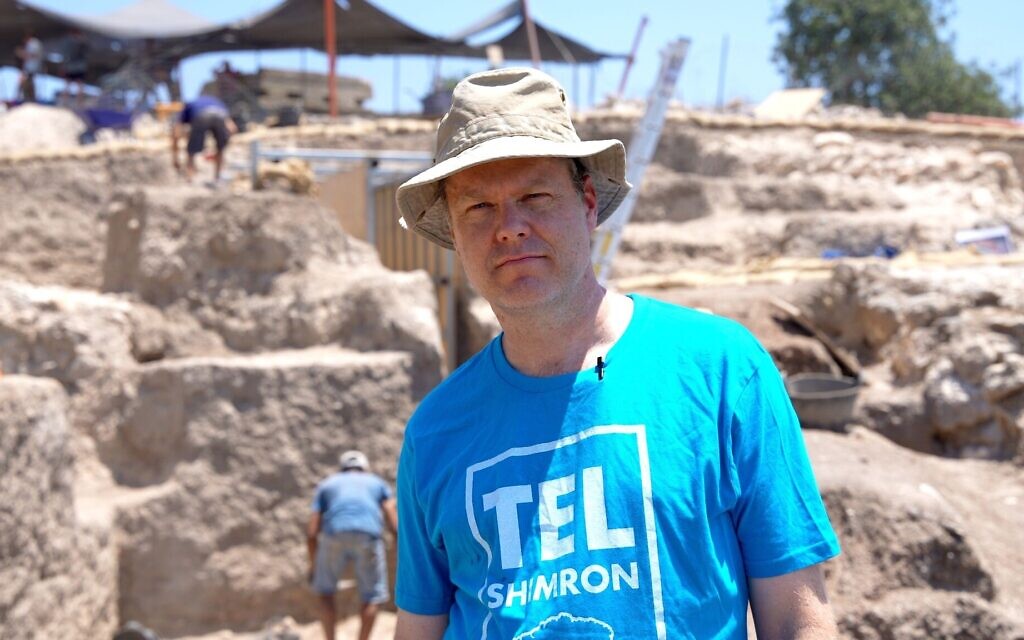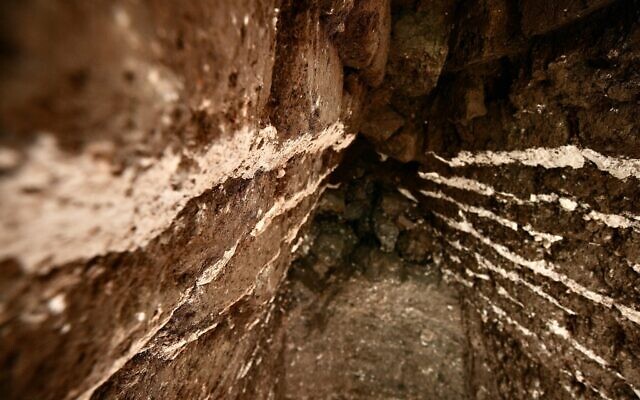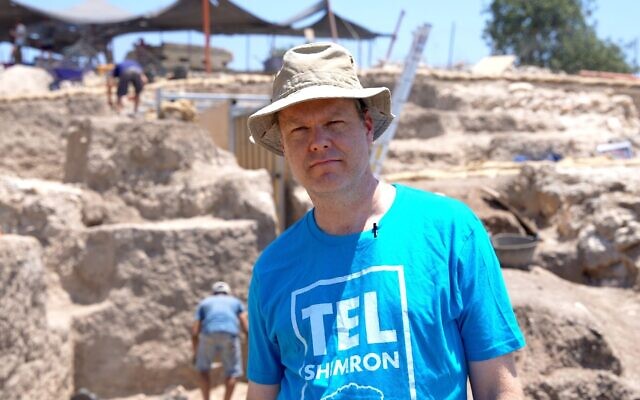by Melanie Lidman
The size of an Olympic swimming pool, with vaulted ceilings that raise the topographical height of Tel Shimron by 5 meters, the delicate mud brick structure was likely barely used
 |
The round knoll of Tel Shimron rises majestically some 70 meters (230 feet) above the Jezreel Valley — but that wasn’t high enough for the rulers of the ancient acropolis during the Middle Bronze Age, who some 3,800 years ago built a massive monument covering nearly the entire top of the hill. Today, archaeologists are trying to figure out why.
Built with mud bricks using the most advanced architectural technology of the time, the monument raised the hill’s height by an additional five meters (15 feet). The complex extends some 1,200 square meters (13,000 square feet) across the top of the hill, about the size of an Olympic swimming pool.
Archaeologists announced the ancient compound’s discovery to the public on Thursday, but don’t go looking for it anytime soon: The monument has been backfilled for preservation and protection and is not accessible to the public.
“When we started digging, we found that this area between the mud bricks was filled with gravel, which is very unusual, so we started removing the gravel,” said Prof. Daniel Master, a professor of archaeology at Wheaton College who has been excavating Tel Shimron since 2017. The current excavation is co-directed by Prof. Mario A. S. Martin of the University of Innsbruk and archaeologists from Tel Aviv University, in cooperation with the Israel Antiquities Authority and the Nature and Parks Authority.
Tel Shimron was not thoroughly excavated before 2017 and the team initially believed it was a typical tel, an archaeological mound made of layers from different time periods. But when the archaeologists started excavating, they found that the first five meters was a man-made structure.
“We kept digging down further, and it was preserved at a depth of one meter, then two meters, then three meters, then four meters,” said Master. “This structure was totally intact, and suddenly we realized we were dealing with the foundation of a building or a superstructure that had been constructed at the top of the site.”
From Mesopotamia with love – and bricks
The recently uncovered complex consists of more than 9,000 unfired mud bricks that were stacked to create a tower and a domed passageway leading down into the city. The two-meter-long passageway is built in “corbelled” fashion, an architectural technique where layered bricks are progressively stepped inward to create a gradually narrowing roof.

This is the earliest documented example of corbelled architecture in Israel, though the technique was widely used in Mesopotamia during this time period, around 3,800 years ago.
This is the era in which Mesopotamians started constructing the first mega-cities, Mari and Ur, which were home to up to 100,000 people. Since Mesopotamia consists of mostly alluvial floodplains with few large stones, locals constructed buildings and dwellings out of mud bricks. At the time, they had the most advanced brick-building techniques in the world, explained Master. The Holy Land’s rocky terrain meant residents could use stones as well as bricks, so their bricklaying technique was less advanced.
At Tel Shimron, the builders even added an artistic flair: a layer of white chalk between the bricks. Working with scientists from the Weizmann Institute, archaeologists determined the white layer was there purely for aesthetic reasons and did not serve as mortar.
Masters is still incredulous that they found intact arches at all, much less with decorations still visible, since unfired mud brick is a delicate material that rarely stands up to the ravages of time.
“You know how it is with archaeology — usually, you have these stumps of walls that raise up no more than a meter, and you just have the foundations,” said Master. “But all of a sudden, here, we’re dealing with a huge monument that has been constructed at the top of this huge city in the Middle Bronze Age, and that really surprised us in terms of conservation.”

A massive monument with an unknown purpose
The monument was so well preserved because soon after it was built, it was completely filled in with gravel, which supported and protected the arches, Master explained. They determined it was barely used because the floor and the stairs of the passageways were also built of mud bricks and show very little wear and tear, meaning very few people walked on it after construction.
The monument’s purpose has stumped the archaeologists.
“Why would you put so much effort into something already 70 meters (230 feet) above valley floor, and make it 75 meters (245 feet) above the valley floor?” asked Master. “What would it mean for the landscape around and how people used the site? What are the social implications for building something so massive at the top of the site?”
At first, Master and others thought the construction may have been walls of an ancient fortified city, possibly to protect the area from conquering Egyptian armies. But every place they found a gate, it led to a dead end.
Some theorize the monument could have religious significance. At the entrance to the main passageway, archaeologists discovered a seven-spouted vessel lying in ashy debris. This type of vessel is called a “Nahariya bowl,” since a similar vessel from the same time period was discovered in Nahariya and used for religious rituals.

A similarly constructed monument is located in Syria, called the White Monument at Tel Banat, also from the Middle Bronze Age. It is believed to be one of the oldest war memorials in the world, due to the systematic placement of the dead on the mound.
A city at the crossroads
The earliest discoveries at Tel Shimron date from the Neolithic period around 9,000 years ago, but the site’s heyday was in the Middle Bronze Age, almost 4,000 years ago. This was when the city was at its largest and stretched for over 19.5 hectacres (195 dunams). It was an important stop for goods and people traveling north toward Anatolia or Caucus, or south to the port at Akko.
The city was known internationally and is mentioned in Egyptian writings from this period.
“In the Bronze Age and Iron Age, Shimron is the hub for controlling the east-west trade, everything from the Jordan Valley to Damascus to Hatzor,” said Master.
The name Shimron is mentioned three times in the Bible, specifically when the Canaanite King of Shimron joined forced with Yavin, King of Hatzor and other kings in a war against Joshua. After Joshua won the war, Shimron passed into the hands of the tribe of Zevulun.
The site was continuously inhabited through modernity, though its population rose and fell. In the 1950s, the area was used for ma’abarot or tent encampments for the wave of new immigrants to the new State of Israel, mostly from North Africa. Visitors today can still see cement platforms where tents were placed, a physical reminder of a controversial period in Israel’s history that was marked by discrimination against the Sephardic Jews who lived in subpar conditions.
Master said one of the reasons he loves excavating Tel Shimron is because the site holds discoveries from every period, from ancient times through the modern state, though the Middle Bronze Age monument has been the most substantial discovery by far.

Tel Shimron is a nature reserve and park that is open to the public, but history buffs hoping to see the monument for themselves are likely to be disappointed. It will take a number of years for archaeologists to fully excavate the monument. So far, they’ve excavated about 500 square meters (5,400 square feet), and there are around 700 square meters (7,500 square feet) to go.
The monument itself is unlikely to ever be opened to the public because it is so delicate. The only reason the structure survived for nearly four millennia was because it was completely filled in with gravel, and that’s likely the best way to preserve it for the future, Master said.
“If you look at other Middle Bronze Age sites, they have many wonderful things, but they don’t have anything like this, because it’s really hard to keep it intact,” he said. Ashkelon, for example, has several mud brick gates from the same period, but none of the arches survived, and the little brick that is left is carefully protected from the elements by a large roof.
“To have this kind of delicate structure preserved for 3,800 years
blew our minds,” said Master. “Everyone we showed it to in the
archaeological community could hardly imagine what they were seeing,
because it’s so rare to have that level of preservation in these
structures.”
Melanie Lidman
Source: https://www.timesofisrael.com/in-northern-israel-massive-3800-year-old-monument-stuns-and-stumps-archaeologists/

No comments:
Post a Comment